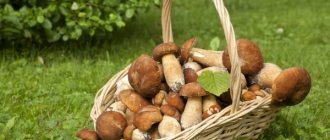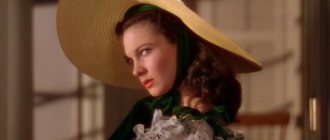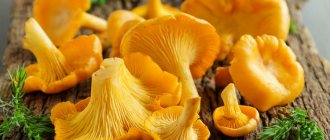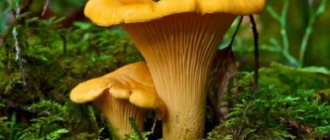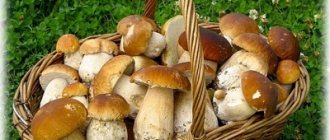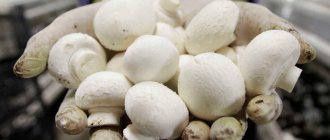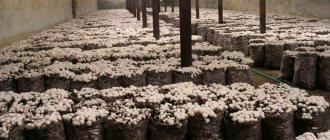The Moscow region occupies a fairly large area - 45,000 km2, a significant part of which is covered with forests. Mushrooms are collected from late spring or early summer. This is the optimal time for a hike, lasting until the first sub-zero temperatures appear. There are many places where to pick mushrooms in the Moscow region: Stupinsky, Kolomensky and the famous Ruzsky districts. Here tourists collect more than one basket of forest gifts.
The best mushroom places of the Moscow region on the map
Silent hunting season in the Moscow region
Based on folk superstitions, you shouldn’t go mushroom picking; everything has changed dramatically. Summer breeds can grow together with spring ones. In July, mushroom pickers generally find russula, boletus, milk mushrooms, chanterelles, and boletus mushrooms, which should come out at different times of the year.
The best mushroom places in the Moscow region on the map Stable growth only in winter honey mushrooms. It is found in mixed forests from early December to late January. But over the past 5-7 years, its seasonality has increased from October to February.
Yield calendar by month for 2022
| January | There are no fruits, but you can look for truffles and oyster mushrooms in the south of the region |
| February March | Only oyster mushrooms |
| April | Stitches and small morels |
| May | Boletus, morels, aromatic russula, boletus |
| June | Beautiful boletus, noble white boletus, aspen boletus, red chanterelle, boletus, russula and everyone’s favorite champignons |
| July | By June honey mushrooms and milk mushrooms are added |
| August | All mushrooms that grow in June-July plus saffron milk caps |
| September | All mushrooms from June-August |
| October | Boletus mushrooms, noble white boletus, aspen boletus, fragrant russula, everyone’s favorite champignons, milk mushrooms and honey mushrooms |
| November | Truffles, oyster mushrooms and honey mushrooms |
| December | Favorite dish of gourmets – truffles and simple oyster mushrooms |
You can start conquering mushroom places in the Moscow region at any time - May-December. But, if you need to harvest a specific type of crop and a lot, this should be done taking into account the decade of growth, and not just the season and weather conditions.
Leningrad direction
It was not for nothing that the Frolovskoe platform was chosen: chanterelles, aspen boletuses, and boletus mushrooms grow here within a radius of two or three miles. It's best to go either west or east. But there is a caveat: there are a lot of ticks, you need to dress well and use repellent. People also get off at the Golovkovo, Povarovka and Radishchevo stations. Here baskets are filled with saffron milk caps, porcini mushrooms, milk mushrooms, chanterelles and russula.
The Firsanovskaya station area is rich in saffron milk caps and boletus mushrooms. Here you can go and try your luck with porcini mushrooms.
Maria Sibirskaya
- 1396
- Add to My sources on Yandex
Where to look for mushrooms
Nearby rivers and reservoirs will not help in the “hunt”. Lakes deprive mushrooms of space. Here on the bolts mushroom pickers find moss mushrooms and boletus mushrooms. You just need to focus on them. In the Moscow region, the most productive areas are abandoned pastures where mixed forest grows. This is a good, fertilized place.
The most productive places are the edges of the forest. If you can see an overgrown field from the train, you can get off at the first station. You don't have to go far into the thicket. But the edges are examined first. Another tip is to pay attention to the root system of trees. The best mushrooms (boletus, boletus, boletus, noble porcini) can be found at a distance of 10-15 meters from the tree, if you walk along the edge.
You should go out for mushrooms at 6 am. The most experienced tourists pitch their tent in the evening and even “hunt” at night with a flashlight.
Mikhail Vishnevsky, mycologist
“Everything has changed a lot since the mid-90s. Mushroom areas are given over to production or built up. It makes no sense to rely on the experience and maps of past years. According to tourists, the Moscow region is a real champion in honey mushroom productivity; there is a lot of it every autumn. Depending on weather conditions, he can go out at any time, but the forest park area and simple forest are not suitable for him. The forests of the Moscow region are the most unkempt and sick. The trees have not been treated with bark beetle for five years; many spruce trees have dried out. Pine trees will soon suffer due to root sponge. For this reason, there are fewer mushrooms. The most productive places are north of the Moscow region and south of the Tula region. You won't get a big harvest in the Moscow region. Again, it all depends on the year and the weather.”
Preparing equipment
Shoes must be good. The sole should be dense so that you are not afraid of sharp knots. Running shoes with membranes, mesh and ventilation will allow moisture to pass through very quickly if it has recently rained or the morning dew has not yet dried.
It is imperative to take a hat with you, simply because this is an important rule for walking in the forest. The rest of the clothing is chosen according to the weather and situation. The better you cover your body, the fewer encounters you will encounter with insects, sharp branches and other delights of nature.
Take a knife with you to cut mushrooms. By the way, it is not at all necessary to cut them off so as not to damage the mycelium. It’s just more convenient: you won’t accidentally break the stem and spoil the mushroom.
You will also need a knife to get yourself a stick. Seriously, if you are not walking through the forest, but specifically looking for mushrooms, you will need a stick to rake leaves without bending down to the ground every time. If you don’t want to train with bending, you’ll have to walk like Gandalf with a magic staff.
You need to take more water and not forget about it, constantly monitor the flow of fluid into the body if you do not want to pay for the walk with a headache from dehydration.
flickr.com
And take a basket for picking mushrooms. Why a basket, basket or other hand-made item? To avoid crushing or breaking the mushrooms, which will definitely happen when using bags or backpacks. Buckets and plastic containers will block air access, and this will also affect the quality of the collected mushrooms. And since you already have a stick, you should also have a basket: then you can take stunning photos of what you’ve collected.
Mushroom routes for tourists in 2022
Ryazan line
Not far from the railway stations there are forests where you can harvest a good harvest:
- Shchurovo - near the village there are forests with coniferous trees, where noble white and red foxes emerge. GPS06504 and 38.85431
- Lukhovitsy – from the platform to the north there is a forest with birch trees. There are also mushrooms at the edge of the lake. GPS98240, 39.04164
- Chernaya - not far from the station in a pine forest there is a whole forest edge with chanterelles and boletus. GPS02699, 38.91891
- Bronnitsy - towards Plaskinino (5 km) and Biserovo. Geodata 50197, 38.34603
- Faustovo – 4 km from the railway station. GPS44524, 38.49572
Belorusskaya line
- Mushroom plantations near the station: Petelino - 60183, 36.82162, Sushkinskaya platforms - GPS 55.61156, 36.87251, Portnovskaya - 55.58911, 36.74547. To the south of the tracks there is a forest area.
- Not far from the settlements of Alyaukhovo and Raevo (st. Khlyupino and Skorotovo), you should move to the southwest. It is better to go north for porcini mushrooms.
Geodata – 55.67911, 36.91190
Gorkovskaya line
Near the Kazanskoye stations and the Fryazevo platform near the settlement of Vsevolodov. Large harvests of mushrooms are harvested 3 km from the village.
Geolocation –55.78873, 38.57695
Kazan line
- Large harvests of noble mushrooms near Konyashino and Minino (Gzhel station) - 62937, 38.42062
- To the north of the Kuzyaevo settlement, “noble” white and chanterelles grow. There are a lot of them in an abandoned children's camp - 60411, 38.54555
Direction Kyiv
- Mushroom settlements near Bekasovo station – 43256, 36.84076
- Fertile places near Bashkino –31777, 36.67271
Kursk line
- There are a lot of mushrooms at the station called Kolkhoznaya. Not far from the platform – 28091, 37.50456
- There are a lot of honey mushrooms near the Sharapova hunting station - 55.04067, 37.47756
- Different species of forest products are found near the Avangard platform, along the coast of the Rechma River - 96140, 37.45122
Direction Leningradskoe
Near Pokrovka station, tourists collect good mushroom harvests.
Geodata – 56.23753, 36.82999
Direction Paveletskoe
- 4 km west of the Barybino platforms, residents collect full baskets of different species - 33370, 37.85077
- On both sides of the railway tracks of the Mikhnevo and Velyaminovo stations, at a distance of 3 km, there are a lot of forest gifts of any kind - 12111, 37.96093
Direction Riga
- Near the Yadroshino platform, residents find boletus, white, honey mushrooms - 55.94807, 36.61300
- From Rumyantsevo there is a real mushroom forest - 99022, 36.54250
- North of the station called Lesodolgorukovo, mushroom pickers reap large harvests. To find the gifts of the forest you need to head towards Nudol-Sharino and Maryino - 01067, 36.34542
Direction Savelovskoe
- Muscovites get off at Turist and Morozko stations and head towards Grigorkovo, Paramonov, Novlyanka. The forests are rich in different species of mushrooms.
56313.27, 37.49864
- There are many chanterelles 4 km from Taldom station in the southwest of the railway platform. 76544, 37.52764
Direction Yaroslavl
- If you get off at the Sofrino platform after 3 km towards the settlement of Novovoronino, you can find mushroom forests. 13534, 37.92941
- There is a good harvest away from the Semkhoz platform; tourists often go here to pick mushrooms. 28331, 38.07749
Naming the exact place where it is best to pick mushrooms in the Moscow region is sometimes difficult even for an experienced tourist. Locals, every year, going on a “quiet hunt”, remember good places, but are not always able to reap a good harvest there in a few years. This is explained by the life cycle. Hobbyists often pull out the prey along with the mycelium, reducing fruiting.
Mikhail Vishnevsky, biologist and mycologist
“The main mistake mushroom pickers make is searching for the harvest at the beginning of the forest edge. If you want to collect a large basket, you need to get to the place and go 2-3 km deep into the thicket. This will increase the chances, making the trip more effective. This way you can collect the fruits not only for cooking roasts, but also for pickling for the winter.”
Hotel Les Art Resort
70 km along the Minsk highway The four-star Les Art Resort hotel is located 70 km from Moscow. Hotel guests will find a shady forest with mushrooms, two-story cottages and five three-story hotels with 250 rooms, a restaurant center, summer sports grounds, a winter skating rink, three swimming pools, a spa and fitness center, an entertainment complex for children, and everything necessary for events and celebrations. There is an Orthodox chapel on site. Les Art Resort operates on an all-inclusive basis.Frequently asked questions and answers
How to find more mushrooms
If you have already found one mushroom, then it is better to sit down next to it and look at the clearing from a different angle - mushrooms grow in “families” and such a change in the angle and field of view will help you find all the representatives of the colony.
Where are the most mushroom places in the forests?
A bountiful harvest should be looked for on forest edges, along roads and paths through the forest, on lawns and clearings, and in other places. Where trees and bushes grow too densely or the grass is tall, it is better not to waste time; there is unlikely to be a bountiful harvest.
Poisonous specimens
Common fly agarics are found in literally all locations where there is tall grass. The pallid grebe prefers oak and linden forests. Satanic boletus usually grows in the southern part of the Chekhov region. Spring entoloma grows in sandy soils. The stinging russula loves open glades in spruce forests. Galerina fringed is extremely rare in the vicinity of Chekhov, but it is all the more dangerous, since inexperienced mushroom pickers confuse it with honey mushrooms.

